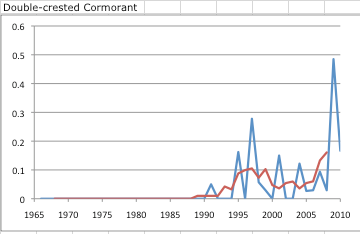Tennessee BBS 1: Waterfowl to Herons
Of the first 15 species, 13 are water birds. Some of these are widespread statewide; many though are limited and subject to the "MAV" effect discussed in the intro.
Canada Goose
All of my graphs will be structured the same as this one. Time runs horizontally from 1966 to 2010. The blue line shows the statewide average count (birds per route) for each year; the red line shows a 5-year moving average of these same data:
 35 year change: +3.31 (+69400%) ± 1.22
35 year change: +3.31 (+69400%) ± 1.22The Canada Goose shows a clear cut (and well-known) example of a new arrival in the region supported by introductions; in this case deliberate stocking of non-migratory populations. After the dramatic increase, numbers appear to have stabilized since about 2000.
Wood Duck
 35 year change: +0.17 (+98%) ± 0.10
35 year change: +0.17 (+98%) ± 0.10This widespread duck shows an interesting pattern of a steady increase followed by a more recent modest decline. The initial rise is doubtless fostered by restoration programs; the apparent recent decline is disappointing.
Mallard
 35 year change: +0.19 (+39%) ± 0.59
35 year change: +0.19 (+39%) ± 0.59Identifying "wild" Mallards in Tennessee in summer is a questionble proposition at best. The large majority of these birds are counted along the shore of Reelfoot Lake, hence whatever the local trend might be it is not particularly meaningful on a large scale.
Like the other "puddle" ducks, Mallards are not sampled very efficiently by the BBS. There have been a few records for other species, but not enough to be worth discussing.
Northern Bobwhite
 35 year change: -26.00 (-78%) ± 2.11
35 year change: -26.00 (-78%) ± 2.11This is one of the most disturbing graphs that came out of this project. Not only has this formerly abundant bird shown a drastic decline, the drop appears to be linear (possibly even accelerating). Projecting this line forward shows a Bobwhite that has been effectively extirpated from Tennessee in 2014 -- just three years away. If you look at the change from 1966 to 2010 (rather than the difference in the 10-year averages), the decline is nearly 90%. In the 1960s this was one of the most abundant species on Tennessee BBS routes; in recent years it is has not been detected at all on many of them.
Wild Turkey
 35 year change:+1.03 (+1273%) ± 0.41
35 year change:+1.03 (+1273%) ± 0.41The converse of the Bobwhite, Wild Turkeys have increased steadily in recent years with restoration programs.
Pied-billed Grebe
 35 year change:-0.01 (-43%) ± 0.02
35 year change:-0.01 (-43%) ± 0.02A few Pied-billed Grebes get spotted occasionally on the MAV counts; no meaningful trend to be had from this limited data.
Double-crested Cormorant
 35 year change:=0.11 (% undefined) ± 0.11
35 year change:=0.11 (% undefined) ± 0.11Cormorants are primarily a MAV bird on the BBS in Tennessee, so this apparent sharp recent increase is based on data from a very few counts. Still, it is marginally significant (statistically), and it agrees with generally observed trends.
Great Blue Heron
 35 year change:=+1.85 (3350%) ± 0.36
35 year change:=+1.85 (3350%) ± 0.36One of the two widely-observed herons on the BBS in Tennessee, Great Blues showed a sharp rise between 1980 and 1990 with fairly stable numbers since then.
Green Heron
 35 year change:=-0.30 (-25%) ± 0.22
35 year change:=-0.30 (-25%) ± 0.22The other widespread heron on the Tennessee BBS, the Green Heron has shown a slight but statistically significant downward trend. It appears that most of this decline occurred between 1980 and 1995, with stable numbers since then.
Other Herons and Egrets
Six other species in this group have been recorded with some regularity on Tennessee BBS routes. In all of these cases, the totals come almost entirely from the two MAV routes in the far northwest corner of the state. They show interesting trend lines, but these generally are not statistically significant and are as likely to reflect shifting local conditions as any larger-scale trend.






Tennessee BBS index:
Introduction
1: Waterfowl to Herons
Next: 2: Vultures to Doves
3: Cuckoos to Woodpeckers
4: Flycatchers to Corvids
5: Larks to Wrens
6: Gnatcatchers to Waxwings
7: Wood Warblers
8: Towhees to Buntings
9: Icterids to House Sparrow
Ups and Downs
Habitats
Inflection Points
Summary


0 Comments:
Post a Comment
<< Home